Neutral palettes, organic textures, and thoughtful simplicity are setting a new standard for bathroom design. Japandi style, a seamless fusion of Japanese minimalism and Scandinavian functionality, offers a calming approach that feels both fresh and deeply intentional. As homes evolve into sanctuaries of peace and mindfulness, this aesthetic has become increasingly popular for those seeking balance and beauty in daily routines. With its focus on clean lines, natural materials, and serene atmospheres, Japandi bathrooms create spaces that promote relaxation and clarity. Understanding how to apply these principles can turn an ordinary bathroom into a retreat that nurtures both body and mind.
Slimline Wood Slat Accent Walls

Integrating slimline wood slat accent walls introduces an effortless balance between warmth and structure within Japandi-inspired bathrooms. These vertical lines naturally draw the eye upward, subtly elongating the space without overwhelming it. Natural wood tones such as light oak or ash fit seamlessly into neutral color schemes, offering organic texture against smooth surfaces like plaster or stone. Maintaining clean alignment and subtle gaps between the slats preserves the minimalist aesthetic while enhancing acoustic comfort and visual depth. In smaller bathrooms, placing wood slats behind the vanity or along a narrow feature wall ensures the room remains airy and uncluttered. Sealing the wood with matte finishes protects against humidity without diminishing the natural grain, critical for maintaining longevity in moisture-rich environments. Paired with complementary elements like floating vanities and soft textiles, these understated slat features deliver a grounded, serene energy—perfect for anyone seeking a calming, contemporary Japandi retreat.
Stone Vessel Sinks on Minimalist Floating Vanities
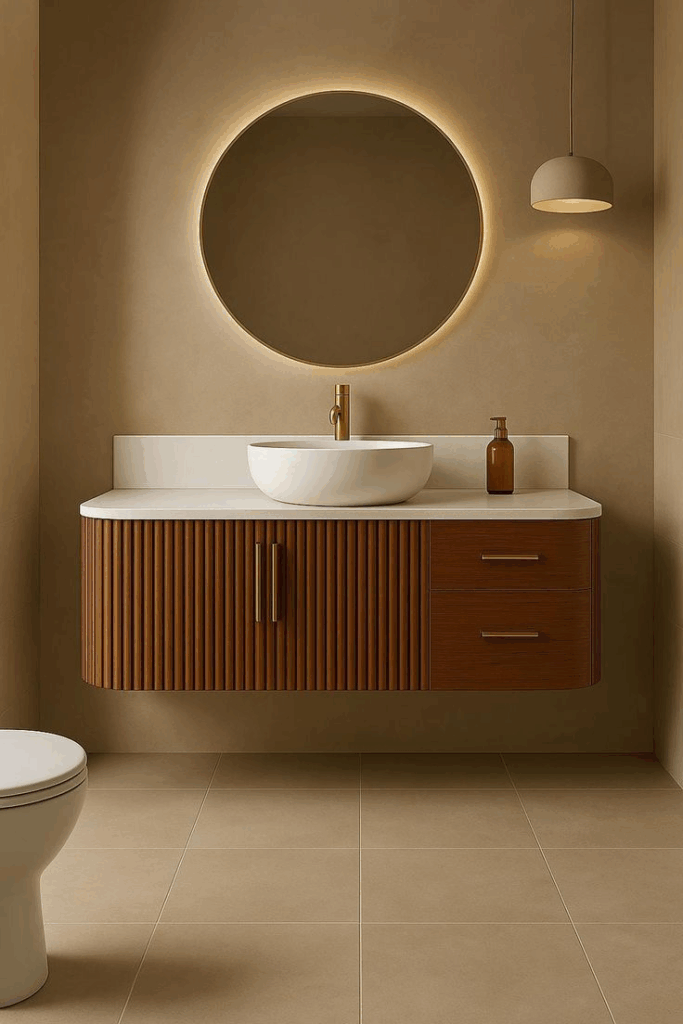
Selecting stone vessel sinks atop minimalist floating vanities reflects a perfect blend of raw material beauty and functional simplicity. Natural stone—whether limestone, marble, or granite—brings tactile richness that softens the precise geometry of streamlined vanity designs. Floating vanities emphasize open space beneath, enhancing the lightness vital in Japandi-style bathrooms. Opting for sinks with organic, rounded forms rather than sharp-edged models ensures a softer visual flow, echoing the wabi-sabi appreciation for imperfection. A muted, honed finish on the stone supports the serene aesthetic while minimizing reflections. Wall-mounted tapware pairs beautifully, reducing counter clutter and emphasizing clean vertical lines. Careful selection of vanity wood tones, ideally in pale, neutral shades, maintains cohesion with the rest of the room’s natural palette. Together, these elements produce a spa-like experience that feels intimate, grounded, and refreshingly uncomplicated—essential for homeowners seeking a balanced intersection between Japanese minimalism and Scandinavian warmth.
Matte Black and Natural Wood Mixed Fixtures

Blending matte black hardware with natural wood accents adds quiet sophistication to Japandi bathroom designs. The contrast between soft, organic textures and sharp, defined metal creates visual interest without disrupting the calm, minimalist tone. Matte black finishes on faucets, shower frames, or towel hooks provide a sleek modernity that harmonizes with the raw, unprocessed character of oak, teak, or walnut vanities. Maintaining slim, uncomplicated silhouettes in fixtures preserves the understated ethos essential to this style. Choosing lighter wood tones prevents the space from feeling heavy, keeping the overall mood gentle and welcoming. Integrating black-framed mirrors or subtle shelving brackets furthers consistency without drawing too much attention. This material pairing respects the Japandi philosophy of intentional contrast—celebrating both strength and softness in the same space. Thoughtful placement of these mixed materials ensures the bathroom remains timeless, not trendy, delivering a balanced, meditative retreat tailored for everyday living.
Neutral Clay-Toned Plaster Walls
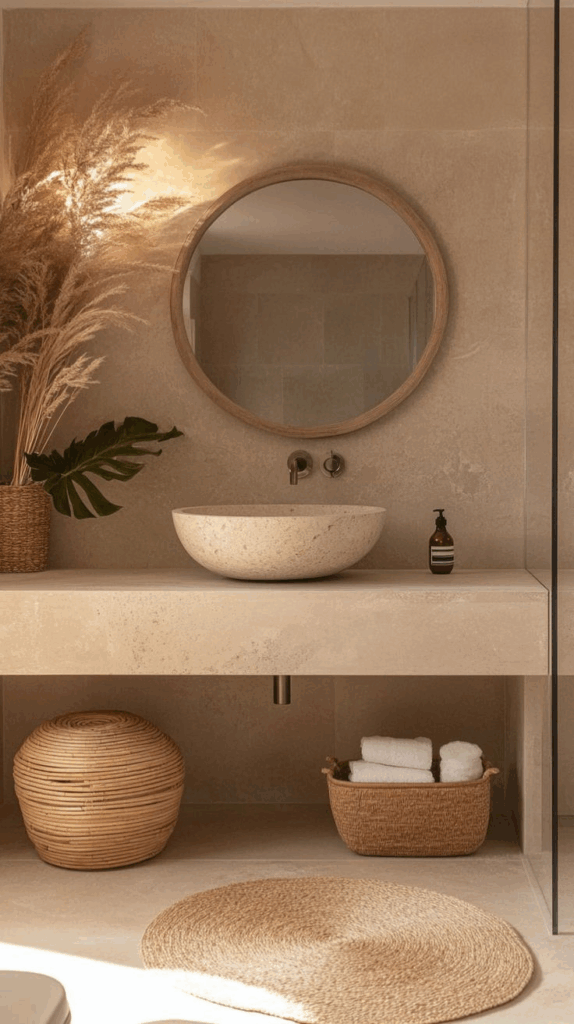
Introducing neutral clay-toned plaster walls nurtures a soft, enveloping atmosphere critical to authentic Japandi bathrooms. Earthy tones like muted beige, soft taupe, or warm greige mimic the natural surroundings revered in both Japanese and Scandinavian design. Clay plaster, with its slight texture and depth, gently diffuses light throughout the space, reducing harsh shadows and fostering a calming environment. Unlike paint or synthetic surfaces, natural plaster provides subtle movement and imperfections, embodying the wabi-sabi principle of beauty in imperfection. Applying it across all walls—or just a singular feature wall—ensures a cohesive, organic backdrop for stone, wood, and linen elements elsewhere in the room. Its breathable qualities make it especially suitable for humid areas like bathrooms, preventing moisture buildup naturally. Pairing these walls with minimalist fixtures and tactile finishes creates a sanctuary that feels effortlessly connected to nature—an essential goal for anyone designing a Japandi bathroom rooted in authenticity.
Built-in Deep Soaking Tubs with Natural Surrounds

Prioritizing built-in deep soaking tubs enveloped by natural materials transforms a Japandi bathroom into a restorative haven. Freestanding tubs may dominate in other styles, but recessed or platform-integrated designs align better with the Japandi preference for seamless integration and simplicity. Surrounding the tub with natural stone, warm timber panels, or textured clay walls deepens the connection to organic elements while enhancing the visual stillness of the space. Choosing tubs with minimalistic lines and softly rounded interiors supports the understated luxury typical of Japanese ofuro traditions. Designing a small ledge or bench into the surround provides functional space for candles, towels, or tea trays, enriching the bathing experience without clutter. Keeping the palette muted—favoring sandy beiges, off-whites, and soft charcoals—preserves the essential tranquility. A built-in soaking tub, thoughtfully enveloped by earth-toned textures, invites quiet reflection and mindful relaxation, perfectly embodying the ethos of a modern Japandi retreat.
Wall-Mounted Tapware with Minimal Detailing
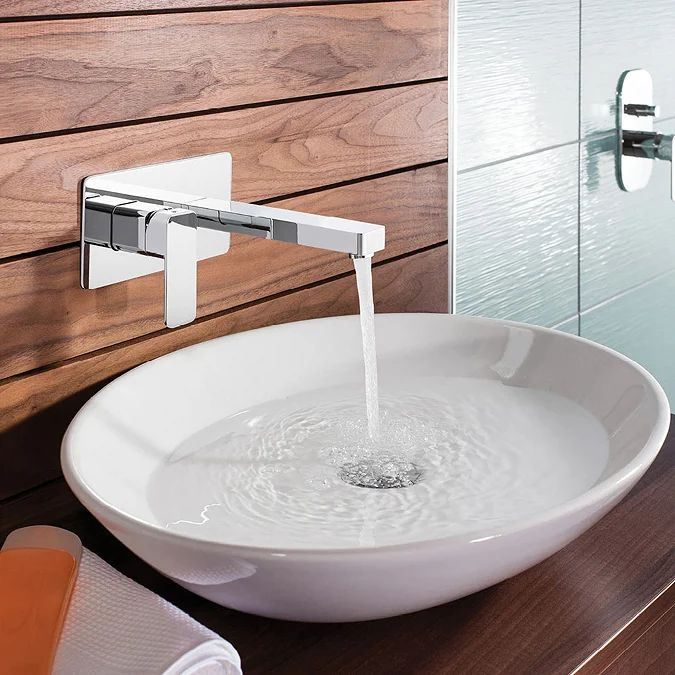
Selecting wall-mounted tapware characterized by minimal detailing promotes both visual clarity and functional refinement in Japandi bathrooms. By moving the faucets off the vanity or tub surface, the design appears lighter, cleaner, and more open—an essential quality for serene interiors. Matte or brushed finishes in black, brass, or stainless steel subtly complement surrounding natural materials without overwhelming them. Opting for slim, gently curved spouts and discreet, easy-to-use levers enhances ease of use while maintaining the focus on simplicity. Strategic placement ensures ergonomic comfort without disrupting the visual harmony of the wall. Whether paired with a floating vanity or a deep soaking tub, wall-mounted fixtures clear precious surface space, making even compact bathrooms feel uncluttered and expansive. Avoiding ornate flourishes keeps the design timeless and centered around essential functionality. Streamlined tapware integrated seamlessly into the overall architecture ensures the entire bathroom reads as calm, cohesive, and intentionally serene.
Oversized Paper Lantern Pendant Lighting
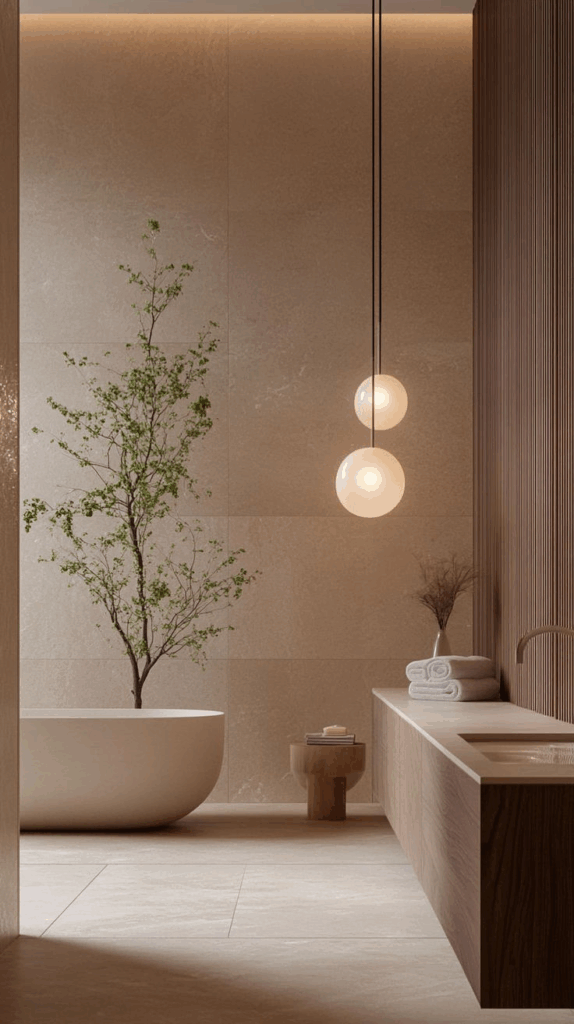
Suspending oversized paper lanterns as central lighting elements infuses Japandi bathrooms with warmth and gentle ambiance. The diffused light quality achieved by traditional rice paper shades casts a soft, calming glow that minimizes sharp contrasts and harsh shadows. Choosing oversized designs helps balance vertical space, making even smaller bathrooms feel open and airier. Opting for organically shaped lanterns—slightly imperfect in silhouette—echoes the wabi-sabi philosophy and fosters visual ease. Hanging a lantern low over a soaking tub or centrally in the room establishes a cozy focal point without dominating the minimalist environment. Lightweight structures ensure safety and easy installation even in humid conditions when treated appropriately. Complementing the lanterns with discrete wall sconces or hidden cove lighting preserves functionality without compromising the meditative quality. A single oversized paper pendant creates an unmistakable feeling of quiet grace, reinforcing the essential connection to natural materials and muted, enveloping illumination central to Japandi design.
Soft Linen Window Drapes for Diffused Light

Installing pure linen window drapes transforms natural light into a soothing, diffused glow ideal for Japandi bathrooms. Linen’s subtle weave texture softens incoming sunlight without blocking it entirely, maintaining the delicate balance between privacy and openness. Choosing undyed or lightly pigmented tones—such as warm white, oatmeal, or pale stone—ensures the drapes harmonize with the room’s muted palette. Floor-length panels hung from discreet minimalist rods allow the fabric to fall naturally, emphasizing effortless, organic beauty. Slight wrinkles and texture irregularities inherent in linen reflect a genuine wabi-sabi charm, making the space feel lived-in yet elegant. In high-humidity environments, pre-washed or naturally breathable linen helps prevent moisture trapping, supporting overall air quality. Keeping the window treatment simple—without ornate pleats, ties, or heavy embellishments—preserves the space’s quiet, unforced elegance. When sunlight gently filters through linen drapes, it bathes the entire bathroom in a serene, nurturing light perfect for daily rituals.
Integrated Wooden Bath Trays and Benches
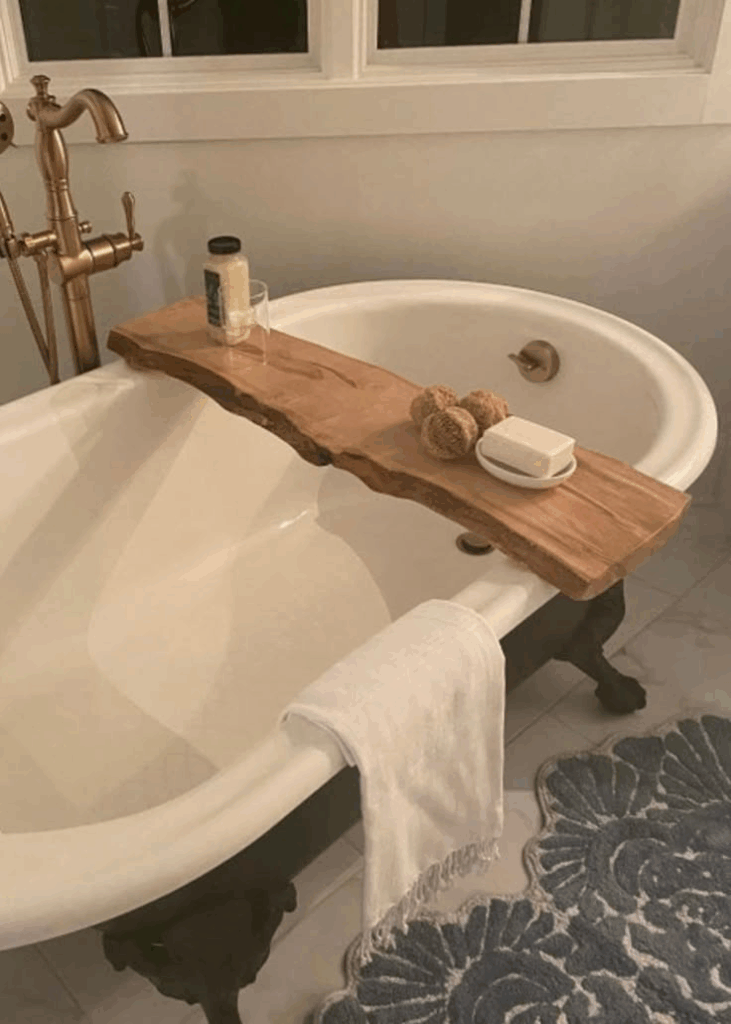
Integrated wooden bath trays and benches fosters practicality and serenity within Japandi bathrooms. These pieces, crafted from teak, oak, or bamboo, serve dual roles—providing storage and enhancing the naturalistic atmosphere central to Japandi style. A bath tray spanning across a soaking tub offers a convenient spot for candles, books, or herbal teas without adding visual clutter. Selecting untreated or lightly finished woods ensures the natural grain shines through, celebrating texture and imperfections. Wooden benches placed adjacent to tubs or inside wet rooms act as grounding elements, offering seating or a surface for folded linens. Clean-lined, low-profile designs maintain visual simplicity, while maintaining durability against moisture is essential for longevity. Positioning these wooden accessories strategically reinforces a sense of ritualistic bathing, enhancing relaxation and mindfulness. Functional yet beautifully understated, integrated wood elements perfectly reflect the balance of purpose and poetry central to Japandi living environments.
River Pebble Textured Shower Floors
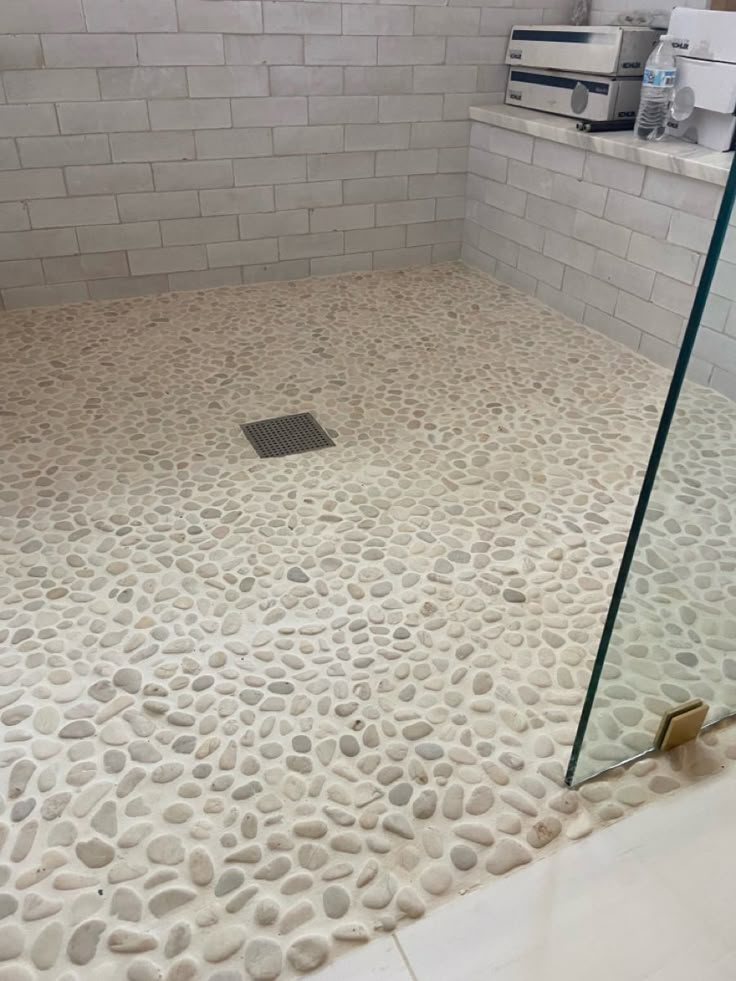
Embedding river pebble textured floors in shower areas introduces a tactile, grounding experience perfect for Japandi bathrooms. The irregularity of natural pebbles beneath bare feet not only massages pressure points but also connects users with nature on a sensory level. Carefully selecting smooth, rounded stones in muted tones—like soft grays, sandy beiges, and pale charcoals—preserves the subtle, earthy color palette integral to this style. Maintaining tight grout joints and a seamless transition between pebbles and surrounding flooring ensures comfort without sacrificing a minimalist aesthetic. Proper sealing keeps the floor water-resistant while enhancing the natural coloration of each stone. This organic flooring choice complements clean-lined fixtures and neutral walls, bringing an unexpected richness to otherwise simple designs. Beyond aesthetics, pebble floors offer practical slip resistance, ideal for wet environments. Introducing river pebbles subtly transforms a shower space into a calming, spa-like oasis, rooted deeply in tactile, grounded Japandi sensibilities.
Muted Sand and Charcoal Two-Tone Palettes
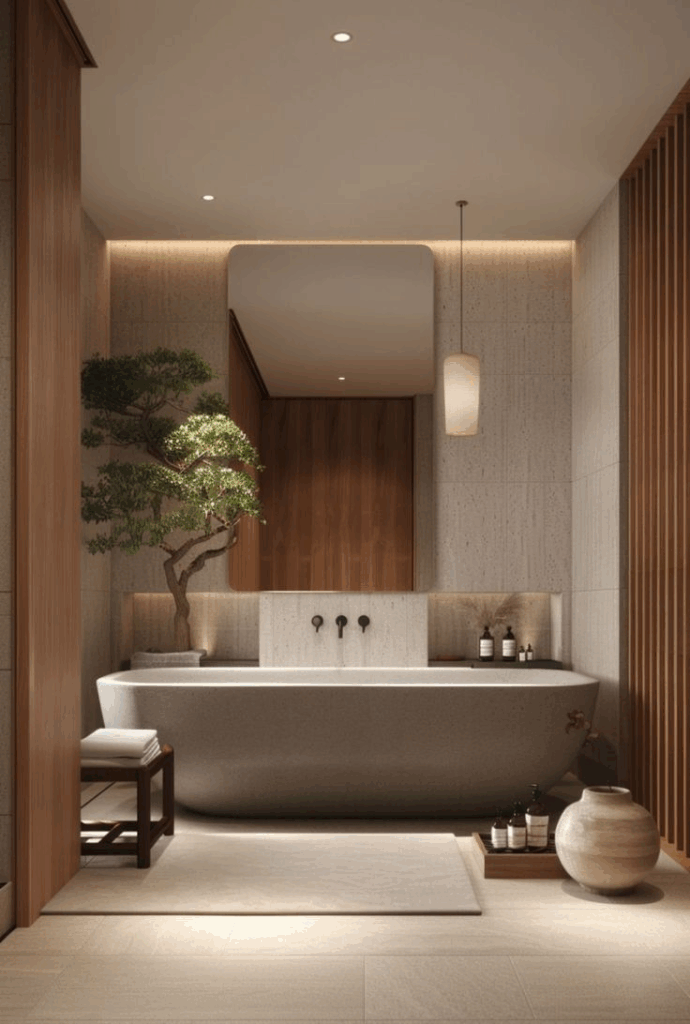
Pairing muted sand and charcoal tones within the bathroom’s color scheme lays the foundation for a sophisticated Japandi environment. Sand shades—ranging from pale beige to soft camel—introduce warmth, while deep charcoals provide anchoring contrast without overwhelming the senses. This restrained palette invites tranquility, allowing natural materials like wood, stone, and linen to shine without competition. Applying lighter tones across dominant surfaces, such as walls and vanities, while reserving charcoal for accent features like niches, shelving, or select fixtures ensures balance and spatial harmony. Ensuring matte finishes across both shades preserves a soft, light-absorbing quality crucial for Japandi’s calming effect. The result feels neither sterile nor heavy but thoughtfully neutral, supporting layered textures and simple forms throughout the space. Muted sand and charcoal together build a timeless, versatile canvas for any Japandi bathroom, offering endless flexibility while steadfastly maintaining the principles of minimalism, nature reverence, and understated elegance.
Slatted Teak Shower Partitions
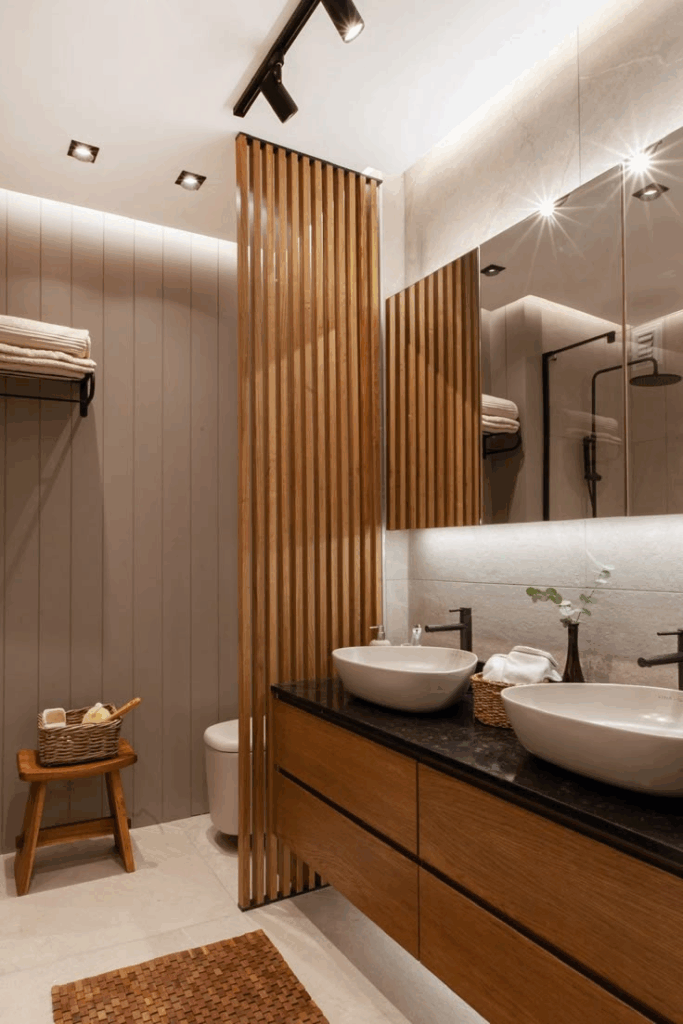
Framing shower zones with slatted teak partitions introduces both functional separation and natural warmth to Japandi bathrooms. Unlike solid glass or tiled walls, slim teak slats maintain visual openness while offering subtle privacy, ideal for open-plan wet rooms. Teak’s inherent resistance to moisture and decay makes it particularly suited for humid environments, ensuring longevity without sacrificing beauty. Narrow gaps between the slats allow light and air to flow freely, enhancing spatial connection and preventing the enclosure from feeling boxed-in. Choosing warm, honey-toned finishes that highlight the wood’s natural grain reinforces the organic palette essential to Japandi style. Installing floor-to-ceiling or half-height slatted dividers depending on space requirements ensures adaptability. Maintaining clean, simple lines without unnecessary embellishments keeps the partition feeling elegant and minimal. Slatted teak structures bridge practical needs and aesthetic aspirations perfectly, fostering a gentle, tactile link between architecture and nature within serene bathroom retreats.
Asymmetrical Round Edge Mirrors
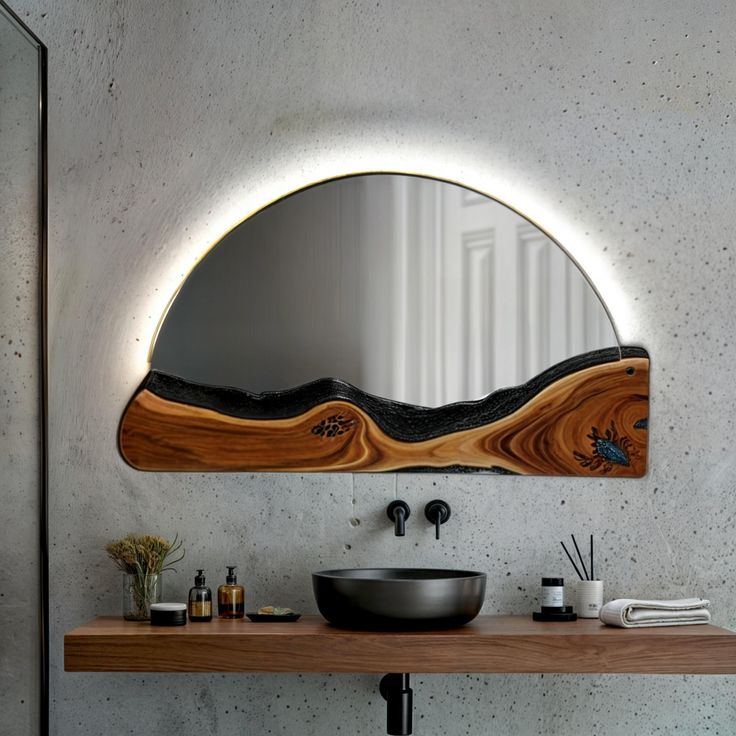
Hanging asymmetrical round-edged mirrors introduces a subtle yet striking design note in Japandi-inspired bathrooms. Departing from traditional rectangular forms, these mirrors—with soft, fluid edges—infuse spaces with a sense of natural movement without compromising simplicity. Frameless or ultra-thin framed designs keep visual weight low, enhancing the bathroom’s airy, uncluttered character. Positioning mirrors slightly off-center above vanities or floating shelves encourages a relaxed, non-uniform aesthetic aligned with wabi-sabi principles. Opting for finishes like brushed brass, muted black, or simple wood ensures consistency with the broader material palette. In smaller bathrooms, asymmetrical mirrors can cleverly reflect more light and expand the perception of space without introducing ornate distractions. Selecting designs with a softly polished edge rather than sharply cut lines preserves the tactile comfort central to Japandi philosophy. Each asymmetrical mirror subtly emphasizes imperfection, authenticity, and beauty, offering a quiet yet powerful focal point essential for tranquil, thoughtfully designed bathroom spaces.
Low-Profile Organic Storage Baskets
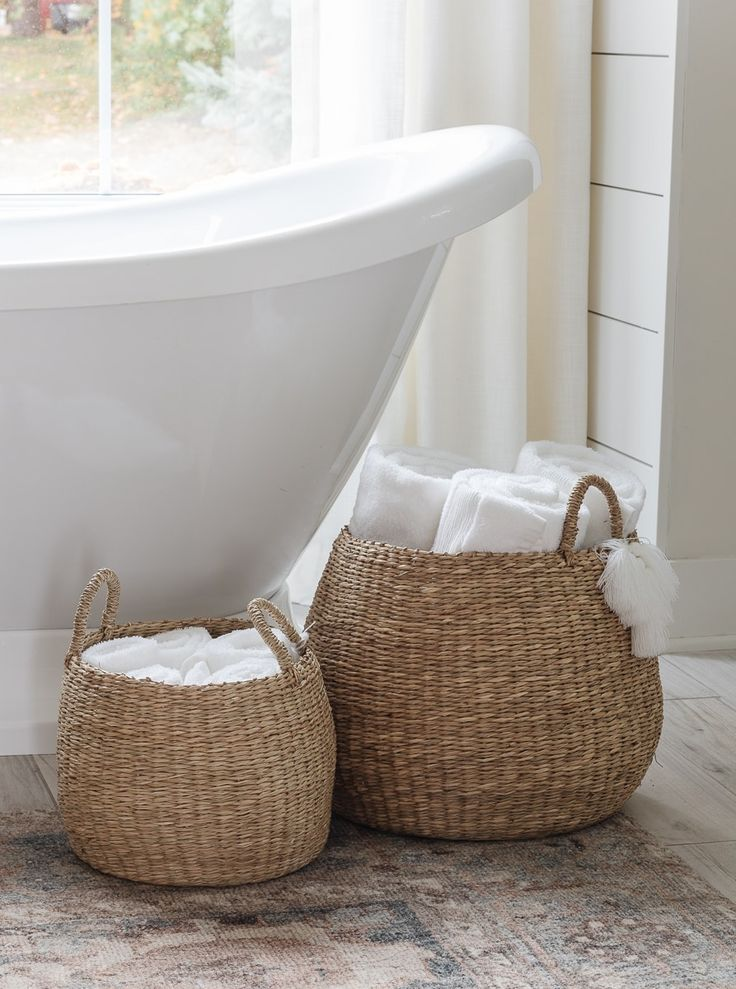
Utilizing low-profile organic storage baskets offers both practicality and understated beauty for Japandi bathroom spaces. Handwoven baskets crafted from seagrass, bamboo, rattan, or water hyacinth introduce texture and a touch of nature while maintaining a soft, unobtrusive presence. Choosing shallow, wide designs ensures they slide effortlessly under vanities, shelves, or benches, keeping essentials neatly organized without visual clutter. Neutral, undyed finishes work best, blending seamlessly with the room’s muted palette and reinforcing a naturalistic feel. Avoiding elaborate patterns or bold colors ensures the baskets support the minimalistic ambiance rather than compete with it. Grouping a few baskets together—one for rolled towels, another for bath products—fosters both order and visual balance. Organic storage solutions like these embrace functional simplicity while celebrating artisanal craftsmanship, two key pillars of Japandi design. Thoughtful placement and restraint ensure that these pieces elevate the bathroom’s authenticity, offering an effortlessly harmonious and serene atmosphere.
Stone-Clad Recessed Shower Niches

Installing stone-clad recessed niches within showers seamlessly blends function and artistry in Japandi bathrooms. Instead of protruding shelves or racks, recessed niches carved into the shower wall maintain clean sightlines and minimize visual clutter, essential for minimalist design. Cladding these niches with natural stone—whether slate, limestone, or travertine—anchors them visually to the organic materials palette while offering subtle textural contrast against smoother tiled or plastered walls. Opting for muted, matte finishes ensures continuity with the overall subdued aesthetic. Carefully sizing niches to fit necessary items like shampoo bottles, soaps, and candles ensures practicality without overcrowding. Lighting recessed niches with hidden LED strips further enhances their sculptural quality without overwhelming the space. Maintaining simplicity in shape—favoring rectangular or elongated horizontal forms—keeps the niches feeling intentional and integrated rather than ornamental. Stone-clad recessed niches subtly celebrate craftsmanship and material honesty, embodying the quiet sophistication essential to a truly harmonious Japandi retreat.
